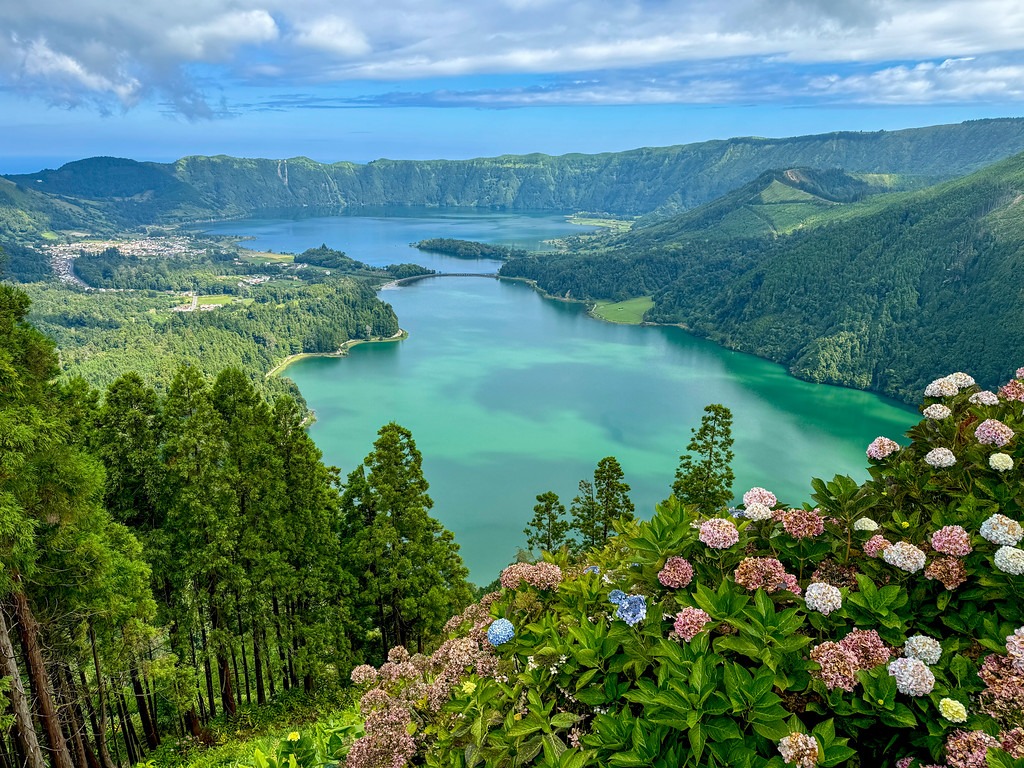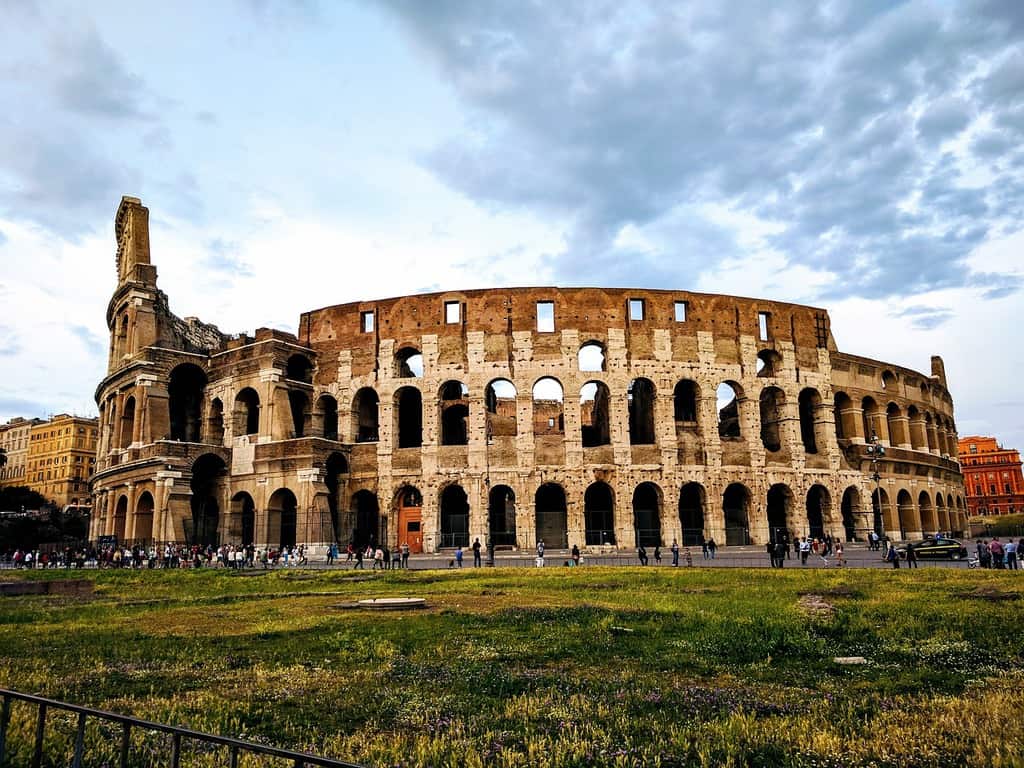A magical chain of islands is nestled in the North Atlantic Ocean. They are known for their stunning blue-green lakes and steaming hot springs. Rolling hills adorned with vibrant hydrangea bushes add to their charm. Often dubbed “the Hawaii of Europe,” these enchanting islands are simply called the Azores.
The Azores consist of nine volcanic islands situated about 870 miles (1,400 kilometers) west of Portugal. Though part of Portugal, the Azores feel like a world apart from Lisbon, Porto, or the Algarve.
The largest and most populous island is São Miguel, where I took my first trip—and certainly not my last! After planning and experiencing this journey, I realized that the Azores remain a hidden gem, unknown to many.
Let me share everything you need to know before embarking on your own Azores adventure. I also have a little local insight you won’t want to miss!
Some posts on this site include affiliate links. This means I may earn a small commission if you make a purchase or booking through them.
Table of Contents
Table of Contents
Know before you go: 10 Azores facts + tips
1. The Azores are part of Portugal
The Azores islands are an autonomous region of Portugal, officially known as Região Autónoma dos Açores. While politically connected to Portugal, the Azores have their own government, including a President.
Portuguese is the primary language spoken in the Azores due to their ties with Portugal. Many locals also speak some English, so English-speaking tourists usually have no trouble. However, learning a few basic Portuguese phrases can enrich your experience.
Here are some simple phrases to get you started:
- Hello – Olá
- Good morning – Bom dia (pronounced “bonn dee-uh”)
- Good night – Boa noite (pronounced “bwoah noyt”)
- Bye – Tchau
- Please – Por favor
- Thank you – Obrigado (if you’re male), Obrigada (if you’re female)
- Do you speak English? – Fala inglês?
2. There are multiple islands
What makes the Azores truly special is that each of its nine islands offers a unique experience! Here’s a quick overview of the islands:
- São Miguel – The largest and most populous island, famous for its stunning lakes, geothermal springs, and delicious local cuisine.
- Terceira – The second most popular and populated island. It is home to Angra do Heroísmo, the Azores’ first designated city and a UNESCO World Heritage Site. The island also offers vibrant hiking trails and lively festivals.
- São Jorge – A long, narrow island in the central Azores known as “The Dragon.” The island is celebrated for its breathtaking views. It features charming villages and renowned cheese. It also hosts a rare coffee plantation.
- Pico – The youngest island, boasting Portugal’s highest peak. It’s renowned for its volcanic landscapes, excellent whale watching, and unique vineyards.
- Faial – The first island settled in the Azores. It is famous for its vibrant hydrangeas. The island features volcanic terrain and the bustling town of Horta.
- Graciosa – A peaceful, central island recognized as a UNESCO World Biosphere Reserve.
- Flores – A lush, nature-focused island celebrated for its summer blooms and spectacular waterfalls.
- Santa Maria – The southernmost island, offering a warmer, drier climate with beautiful hiking trails and inviting beaches.
- Corvo – The smallest and most remote island, with just 400 residents, popular among bird watchers.
The islands are spread out, so traveling between them requires some planning. To reach islands like Terceira, Pico, or Flores from São Miguel, you must take an inter-island flight. These flights are available via SATA/Azores Airlines. The only islands easily connected by ferry are the central trio. These are Pico, Faial, and São Jorge. They are known as the Ilhas Triângulo, or Triangle of Islands.
If you plan to explore multiple islands during your Azores adventure, allow ample transit time. This will help you make the most of your trip!
3. The Azores are easy to get to
When most people hear “remote island chain in the middle of the Atlantic,” they likely assume it’s difficult to reach. The good news? Getting to the Azores is actually quite easy.
There are multiple daily flights to several Azorean islands from Porto and Lisbon. There are also daily direct flights to Ponta Delgada (PDL) on São Miguel from major European cities. These cities include Paris, London, Frankfurt, Brussels, Madrid, Milan, and more. Additionally, there are daily direct flights from US cities such as Boston and New York.
Direct international flights also serve the island of Terceira.
SATA/Azores Airlines is the primary airline operating to and within the Azores. You can also find flights with TAP Air Portugal and Ryanair within Europe. United Airlines provides flights from the US. (My husband Elliot and I flew direct from Newark to Ponta Delgada, a flight that takes about five hours.)
The Azores are continuing to grow in popularity. I expect even more direct flights to be added in the coming years.
4. Renting a car is the best way to get around
Once you arrive in the Azores, renting a car is by far the best way to explore the islands. You might prefer joining a multi-day guided tour instead.
Even on São Miguel, the largest island in the Azores, public transportation options are limited. While taxis are available, having your own car is essential if you want to discover every corner of the island.
The roads on most islands, especially the larger ones like São Miguel, are well-maintained and easy to drive on. In fact, navigating São Miguel is straightforward and stress-free. Drivers stay on the right side of the road. Visitors from the US and Canada will find it familiar. It will be comfortable for them.
Car rentals are available on all the Azorean islands. It’s wise to book in advance due to the limited number of vehicles.
If you prefer guided tours, consider this option by Collette, which covers multiple islands and even includes Lisbon.
5. This is not Hawaii
Yes, you will find pineapples and high humidity in the Azores, and these islands were also formed by volcanic activity. However, the similarities to Hawaii largely end there.
Some refer to the Azores as “the Hawaii of Europe.” However, the two island groups differ significantly. This is especially true in terms of climate and scenery.
Hawaii boasts a hot, tropical climate, while the Azores enjoy a more temperate and mild atmosphere. Unlike Hawaii’s relatively stable weather, the Azores experience seasonal changes. Winter temperatures average 55-60°F. Summer temperatures range from 70-80°F.
The landscapes are distinct as well. Hawaii is known for its palm trees and stunning white and golden sandy beaches. In contrast, the Azores feature rolling green farmland reminiscent of Ireland, along with striking black sand and lava rock beaches.
RELATED: The Best Things to Do in Hvar Island, Croatia (Beyond the Party Scene)
6. The Azores aren’t a beach vacation
Speaking of beaches, the Azores aren’t typically known as a beach destination. There are beautiful beaches scattered throughout the islands. However, many can be difficult to access. The cooler climate means the water isn’t always warm enough for swimming.
Additionally, most islands feature black sand or black lava rock beaches. These beaches aren’t ideal for sunbathing. However, many visitors still enjoy relaxing on them!
7. Be ready to be outdoors
Many travelers visit the Azores specifically to hike. While hiking isn’t essential to enjoy your trip, it’s wise to be prepared for outdoor activities. Why? Because most of the top attractions in the Azores involve some level of outdoor adventure!
We went beyond hiking and explored wind-swept viewpoints. We wandered through a tea plantation and relaxed in thermal baths. We took boat trips and visited fumaroles. We also strolled in parks and gardens. Additionally, we enjoyed beach sunsets. Reflecting on it, many of our meals were even enjoyed outdoors.
The Azores are renowned for their stunning landscapes. To truly experience their beauty, you’ll spend most of your time outside.
8. Prep for all the weather
You will likely spend a lot of time outdoors. Therefore, it’s important to be prepared for all types of weather in the Azores.
The weather in the Azores can change rapidly. This is common in many island destinations, especially those located far out in the middle of the ocean. Pack according to the temperature forecast for your trip. Always be prepared for sun, clouds, wind, rain, and humidity. These conditions might occur all in one day, sometimes in quick succession.
Elliot and I visited the Azores in September. The forecast predicted mostly sunny weather. However, we were grateful to have rain jackets with us more than once.
RELATED: Everything You Need to Know About Visiting Pearl Harbor in Hawaii
9. It’s not built for mass tourism
The economy of the Azores is primarily driven by agriculture, especially dairy and livestock farming, along with fishing. Tourism plays a role as well, but it remains secondary to these traditional industries.
I visited São Miguel, the largest and most populous island in the Azores. Even there, it’s clear the island isn’t designed for mass tourism. In fact, some places might struggle if tourism expands too rapidly. At the Gorreana Tea Plantation—the only tea plantation in Europe—it was nearly impossible to navigate the narrow one-way driveway. Large tour buses squeezed past cars parked alongside the bushes.
Each island has a few popular tourist spots. The Azores aren’t exactly a secret—especially among European travelers. However, they’re far from a party hotspot or a place filled with sprawling resorts and multi-lane highways.
Despite being the biggest island, São Miguel still feels largely rural and authentic beyond the main attractions. You’ll find more local bars and eateries than tourist-oriented venues. Small houses with bowls of food are left out for local cats at scenic viewpoints. There are beaches where you won’t be hassled by vendors.
Help preserve the Azores’ unique charm by being a responsible visitor. Support local businesses, clean up after yourself, and stick to marked trails. Be respectful and considerate throughout your stay.
10. You need to book ahead
Many people have heard of these beautiful islands. So, even if you’re not very familiar with traveling to the Azores, rest assured of their popularity. The Azores experience a high tourist season from June to August, with May and September also seeing considerable activity. The islands are mainly composed of small towns. Ponta Delgada is the largest city in the archipelago. It has a population of just around 68,000.
The Azores don’t attract the massive crowds of more famous destinations. However, the limited number of accommodations means these can fill up quickly during peak season. Rental cars are also limited. If you’re planning a summer visit, it’s wise to book hotels and rental cars several months ahead whenever possible.
We visited São Miguel in September. It was nearing the shoulder season. Many hotels were already fully booked by July when I started searching. For smaller islands with even fewer lodging options, planning well in advance is even more crucial.
Check hotel and rental car availability before booking your summer flights to the Azores. This will help you avoid any unpleasant surprises. Imagine purchasing non-refundable tickets only to discover that all desirable hotels are booked or affordable car rentals are gone.
Making dinner reservations at popular restaurants, especially in Ponta Delgada, is also a good idea.
That said, despite these precautions, São Miguel didn’t feel crowded during our visit. It felt crowded only at the tea plantation, which was noticeably busier.
With this insider knowledge, you can plan your Azores trip more confidently. It’s a fantastic destination, and I’m certain I’ll return.
Have you ever visited the Azores? If not, are you ready to start planning your trip now?
RELATED: Everything You Need to Know About Visiting Pearl Harbor in Hawaii



